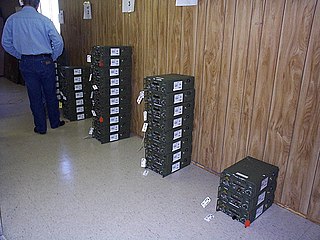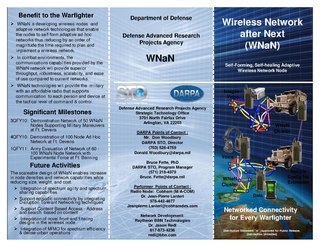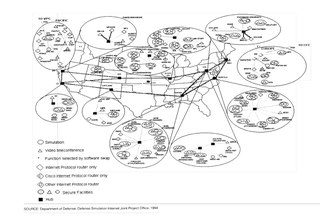
Packet radio is a digital radio communications method used to send packets of data. Packet radio uses packet switching to transmit datagrams. This is very similar to how packets of data are transferred between nodes on the Internet. Packet radio can be used to transmit data long distances.

Raytheon BBN is an American research and development company, based next to Fresh Pond in Cambridge, Massachusetts, United States.

The Advanced Research Projects Agency Network (ARPANET) was the first wide-area packet-switched network with distributed control and one of the first networks to implement the TCP/IP protocol suite. Both technologies became the technical foundation of the Internet. The ARPANET was established by the Advanced Research Projects Agency (ARPA) of the United States Department of Defense.

Robert Elliot Kahn is an American electrical engineer, who, along with Vint Cerf, first proposed the Transmission Control Protocol (TCP) and the Internet Protocol (IP), the fundamental communication protocols at the heart of the Internet.

A wireless mesh network (WMN) is a communications network made up of radio nodes organized in a mesh topology. It can also be a form of wireless ad hoc network.

The Near-term digital radio (NTDR) program provided a prototype mobile ad hoc network (MANET) radio system to the United States Army, starting in the 1990s. The MANET protocols were provided by Bolt, Beranek and Newman; the radio hardware was supplied by ITT. These systems have been fielded by the United Kingdom as the High-capacity data radio (HCDR) and by the Israelis as the Israeli data radio. They have also been purchased by a number of other countries for experimentation.
Delay-tolerant networking (DTN) is an approach to computer network architecture that seeks to address the technical issues in heterogeneous networks that may lack continuous network connectivity. Examples of such networks are those operating in mobile or extreme terrestrial environments, or planned networks in space.

A computer network is a set of computers sharing resources located on or provided by network nodes. The computers use common communication protocols over digital interconnections to communicate with each other. These interconnections are made up of telecommunication network technologies, based on physically wired, optical, and wireless radio-frequency methods that may be arranged in a variety of network topologies.
6LoWPAN is an acronym of IPv6 over Low-Power Wireless Personal Area Networks. 6LoWPAN is the name of a concluded working group in the Internet area of the IETF.
A wireless ad hoc network (WANET) or mobile ad hoc network (MANET) is a decentralized type of wireless network. The network is ad hoc because it does not rely on a pre-existing infrastructure, such as routers in wired networks or access points in wireless networks. Instead, each node participates in routing by forwarding data for other nodes, so the determination of which nodes forward data is made dynamically on the basis of network connectivity and the routing algorithm in use.
Routing in delay-tolerant networking concerns itself with the ability to transport, or route, data from a source to a destination, which is a fundamental ability all communication networks must have. Delay- and disruption-tolerant networks (DTNs) are characterized by their lack of connectivity, resulting in a lack of instantaneous end-to-end paths. In these challenging environments, popular ad hoc routing protocols such as AODV and DSR fail to establish routes. This is due to these protocols trying to first establish a complete route and then, after the route has been established, forward the actual data. However, when instantaneous end-to-end paths are difficult or impossible to establish, routing protocols must take to a "store and forward" approach, where data is incrementally moved and stored throughout the network in hopes that it will eventually reach its destination. A common technique used to maximize the probability of a message being successfully transferred is to replicate many copies of the message in hopes that one will succeed in reaching its destination.
The history of delay-tolerant networking examines the bulk of the technologies that began the field that is known today as delay-tolerant networking. Research began as projects under United States government grants relating to the necessity of networking technologies that can sustain the significant delays and packet corruption of space travel. Initially, these projects looked only short-range communication between manned missions to the moon and back, but the field quickly expanded into an entire sub-field of DTNs that created the technological advances to allow for the Interplanetary Internet.
A mobile wireless sensor network (MWSN) can simply be defined as a wireless sensor network (WSN) in which the sensor nodes are mobile. MWSNs are a smaller, emerging field of research in contrast to their well-established predecessor. MWSNs are much more versatile than static sensor networks as they can be deployed in any scenario and cope with rapid topology changes. However, many of their applications are similar, such as environment monitoring or surveillance. Commonly, the nodes consist of a radio transceiver and a microcontroller powered by a battery, as well as some kind of sensor for detecting light, heat, humidity, temperature, etc.
Associativity-based routing is a mobile routing protocol invented for wireless ad hoc networks, also known as mobile ad hoc networks (MANETs) and wireless mesh networks. ABR was invented in 1993, filed for a U.S. patent in 1996, and granted the patent in 1999. ABR was invented by Chai Keong Toh while doing his Ph.D. at Cambridge University.

The Packet Radio Network (PRNET) was a set of early, experimental mobile ad hoc networks whose technologies evolved over time. It was funded by the Advanced Research Projects Agency (ARPA). Major participants in the project included BBN Technologies, Hazeltine Corporation, Rockwell International's Collins division, and SRI International.

The Wireless Network after Next (WNaN) was a DARPA project to create and demonstrate an advanced tactical mobile ad-hoc network (MANET) that rapidly adapts to soldiers maneuvering in complicated environments, automatically determining the best radio frequencies and network path to maximize connectivity and throughput. In 2010 it was successfully demonstrated in live military experiments containing up to 100 nodes, the largest military MANET demonstrated to that date.

The Defense Simulation Internet (DSI) was a specialized, wide-area network created to support Distributed Interactive Simulation and videoconferences. It was sponsored by DARPA, and built and operated by BBN Technologies from about 1991-1995, after which time it was operated by the Defense Information Systems Agency (DISA).

The ARPANET pioneered the creation of novel encryption devices for packet networks in the 1970s and 1980s, and as such were ancestors to today's IPsec architecture, and High Assurance Internet Protocol Encryptor (HAIPE) devices more specifically.










